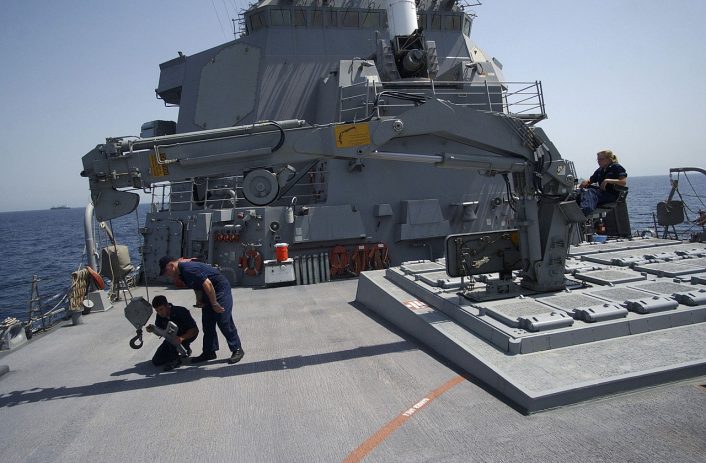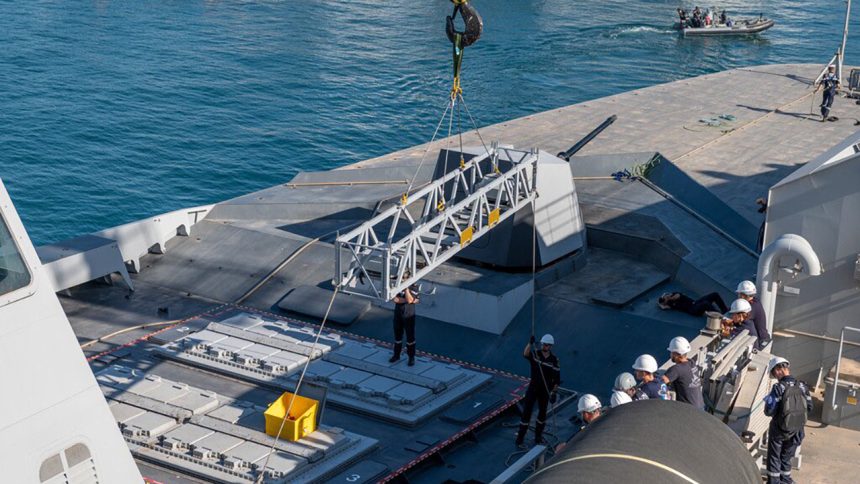The French Navy has revealed the testing of a new capability to resupply and reload vertical launch system (VLS) missiles on warships from its newest generation of fleet logistics vessels.
Photos released by the French Navy, or Marine Nationale, on its X social media account have demonstrated a new development that would allow greater flexibility in the force’s ability to restock missile payloads on its surface ships. Using the Aquitaine class air defence frigate Lorraine (D657) as the receiving ship, the newly commissioned resupply vessel Jacques Chevallier was seen transporting a VLS missile canister from its deck inside a metal frame across to the frigate, where it was then loaded in a VLS silo assisted by the resupply ship’s crane.
#Expérimentation | Ravitaillement en munitions complexes entre le BRF Jacques Chevallier et la FREMM-DA Lorraine. En escale, un BRF pourra ravitailler une FREMM sans infrastructures portuaires adaptées. Cette expérimentation préfigure l’admission au service actif du BRF. pic.twitter.com/zZNWkqTdFB
— Marine nationale (@MarineNationale) June 26, 2024
This news comes following a Marine Nationale post last month showing the transfer of another VLS missile canister, containing an Aster air defence missile, between Jacques Chevallier and the nuclear-powered aircraft carrier Charles de Gaulle. The aircraft carrier’s large, flat deck is an innate advantage for this type of operation as a mobile crane can be deployed to lift the canister into the silo, which is not possible in the same way on a frigate or destroyer.
#Akila | Opérer plus loin et plus longtemps ! 👊 C’est possible avec le 1ertransfert en mer de missile Aster, réalisé entre le BRF Jacques Chevallier et le #CDG ! Opération complexe qui illustre la capacité d’adaptation de la Marine au profit de l’engagement de ses unités. pic.twitter.com/n4aMcM193w
— Marine nationale (@MarineNationale) May 13, 2024
Unlike the turret-based air defence missile systems used by the United States Navy’s Gerald R. Ford class and Nimitz class aircraft carriers, Charles de Gaulle uses VLS silos to launch its air defence missiles. This approach is shared by the Italian aircraft carrier Cavour. Both methods have positives and negatives: a VLS approach allows all-round coverage without needing to position turrets to strategically cover all corners of the ship, but in the event of a missile failure there is a greater likelihood that the flight deck would be fouled by foreign object debris. Turreted launchers like the Mk 29 Enhanced Sea Sparrow Missile and Mk 49 Rolling Airframe Missile launchers used on U.S. Navy carriers however allow for a closer minimum engagement distance, as a launched missile would not first need to orient itself towards a target before engaging it, and these launchers usually require minimal deck penetration below the mount.
The Search for a Better VLS Resupply Method
Reloading VLS silos at sea has become an increasingly discussed subject since coalition warships have been engaged against missile and drone attacks in the Red Sea. The limited stocks held in each ship of anti-air missiles have required ships to take lengthy journeys to and from allied ports to resupply, as currently they are unable to reload these missiles while at sea.
.@hmsdiamond embarking replacement Sea Viper missiles in #Gibraltar this morning ahead of returning to the Red Sea soon.
Gibraltar once again demonstrating its value as a forward support base.
Via @key2med pic.twitter.com/l9iV8nqivr
— Navy Lookout (@NavyLookout) February 25, 2024
In the longer term, various naval forces hope to deploy laser-based defensive systems which would expend only electrical power, rather than ammunition. In the meantime however, while these systems are developed to a point where they could be operationally deployed against high tier threats such as missiles, warships will continue to rely on missiles to engage many types of aerial targets.
The specific scenario in the Red Sea in fact highlights a potential shortcoming of laser weapons, as ships have been engaging many threats that were not targeting their own ships but civilian ships in the general area. Complex anti-air missiles have been used to engage comparatively lower tier threats, such as suicide drones, because the engagement range would preclude using guns or, if theoretically equipped, laser weapons.
The U.S. Navy has been developing a similar ship-to-ship VLS reload system since at least 2016, and publicly revealed trials of the system in October 2022. A primary motivation in the U.S. military for this capability has been the potential for future conflict in the Pacific, where safe, friendly ports may be thousands of miles from an operational area. At present, though, it has only been demonstrated while alongside in port. This is still an improvement, as it means the task could be accomplished at essentially any friendly port rather than those that meet the security, storage and handling requirements for live weaponry, but it is still only part-way towards the desired at-sea replenishment capability.
The Mark 41 VLS used by U.S. and many allied vessels was previously fitted with a collapsible crane that was intended to be used to assist with replenishing missile stocks, but this was found to be difficult to use in a safe manner and fell out of use following the introduction of the Flight IIA Arleigh Burke class destroyers in the early 2000s. An additional downside of this system was that it reduced the total missile capacity of the ship, as the crane took the space of three cells in each eight cell VLS module. Assuming one crane module per fore and aft cluster of VLS cells, this would mean six fewer missiles available.

France, along with several other European nations, uses the Sylver VLS platform, which was developed by France to field the various European ship-launched missile designs currently in service. This includes the Aster, Crotale and Mica air defence missiles, as well as the Storm Shadow/SCALP-EG derived MdCN cruise missile. Unlike the Mark 41, Sylver has never been deployed with a strikedown crane module.
The United Kingdom also recently confirmed it was investigating the possibility of developing a greater VLS replenishment capability, potentially including at-sea resupply. The Royal Navy currently uses the Sylver VLS platform on its Type 45 Daring class destroyers, along with a bespoke cold-launch VLS as part of the Sea Ceptor system fitted to Type 23 frigates. The Type 45 destroyers will be receiving 24 cells of this type in addition to its existing 48 cell Sylver system in a future upgrade. The Sea Ceptor system and cold-launch silos of the Type 23 frigates will carry over to the new Type 26 City class frigate, but the new frigates will also be equipped with Mark 41 VLS cells for other missile types, such as land attack missiles. The lack of a land attack capability on Royal Navy surface vessels beyond the Mark 8 4.5in naval gun has been subject to some criticism during the Red Sea crisis. The Type 31 Inspiration class frigates will reportedly be equipped solely with Mark 41 silos, and will likely field the CAMM missiles used as part of the Sea Ceptor system in those cells.









